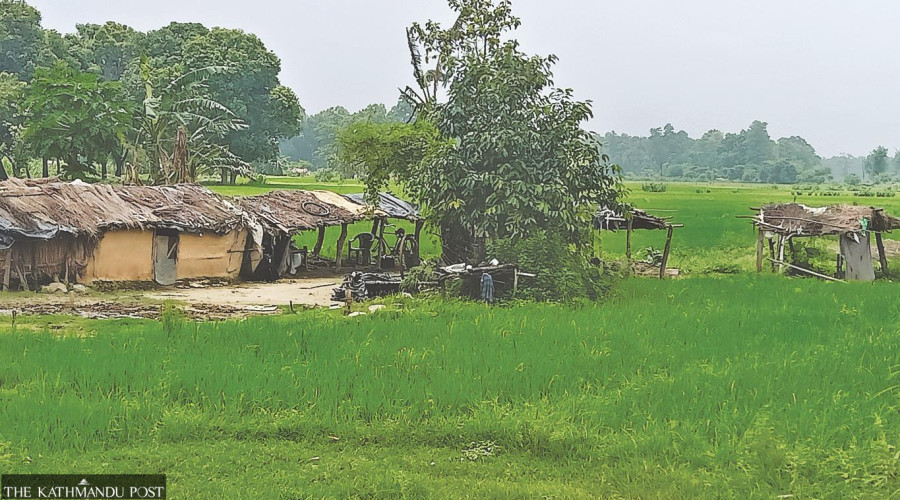National
Failure to rehabilitate families displaced by national park detrimental to humans, wildlife
While humans live in constant fear of wild animal attacks, the latter find their natural habitats disturbed by human activities.
Bhawani Bhatta
The Dakka camp is nestled amidst the forests in one of the core areas of Shuklaphanta National Park. The camp is home to around 604 families displaced during the construction and expansion of the national park that started in 1977 and concluded in 2007.
When the park expanded its eastern front, dozens of settlements were displaced and around 5,200 families were rehabilitated by the Ministry of Forest and Environment. Hundreds of families now reside in various camps—Dakka, Tarapur and Lallare—set up inside the park over the years. Among the displaced camps, Dakka is the largest while Tarapur camp houses 180 families and Lallare 13 families.
Living inside the camps is difficult and unsafe, with the residents left with constant fear of wild animals which not only threaten their lives but also destroy the crops they grow. Meanwhile, the close proximity in which humans and animals live inside the park has not just affected humans but also the wildlife.
While humans live in constant fear of wild animal attacks, the latter find their natural habitats disturbed by human activities leading to frequent human-wildlife conflicts.
“Our life is hell inside the forest,” said Hirasingh Bhandari, 65, who lives in the Dakka camp. “We try to grow crops for our own consumption but the animals get to them before we do. When the elephants enter the settlement, we forget about protecting the crops. We have to run for our lives.”
One person was killed by an elephant in the Dakka camp last year, according to Bhandari.
After its expansion on the eastern side, the Shuklaphanta National Park now spreads across 305 sq km. Though it is among the smaller national parks in Nepal, it boasts as many as 36 tigers, according to the latest census.
The presence of humans inside the protected area has proved detrimental to the growing tiger population, say conservationists.
According to Lakshmiraj Joshi, chief of the Suklaphanta Conservation Programme under the National Nature Conservation Fund, the tiger density is less on the east of the Chaudar river and negligible in the expanded east zone. Most of the tiger population is concentrated in the original area of the national park, Joshi said.
“Only a few of the big cats venture into the expanded territory but they don’t settle there. They tend to come back to their original habitat,” he said.
The presence of human settlements inside the park area deters the tigers from moving freely, Joshi added.
“Infrastructure development activities inside the park area also affect the movement of tigers,” he said. “The second phase of the Mahakali irrigation project is underway and so is the construction of the Kaluwapur-Belauri road section and the East-West Highway. The construction of the Mahakali irrigation project to the north has divided the park into different sections. This has hindered the movement of wild animals inside the park area.”
Dakka and Tarapur camps sit between Laljhadi Mohana Protected Area and Shuklaphanta National Park. This narrow junction between the two protected areas is the traditional route used by wild animals but the presence of humans in the bio-corridor has affected the movement of wild animals, according to Manoj Air, assistant conservation officer of the park.
Earlier, herds of elephants migrating from Dudhuwa National Park of India through Laljhadi forest would make their way back within a month or two of their arrival but in the past few years they haven’t been able to return because their traditional route is blocked by human settlements. “This is why elephants are increasingly entering human settlements and wreaking havoc,” said Air.
According to Air, officials from the Pilibhit Tiger Reserve in India have also reported an increase in elephant-human confrontations. “The traditional bio-corridor has been encroached upon by human settlements,” Air said. “The elephants find humans in their path and end up destroying huts and attacking people.”
The park lies close to the Indian border and is thus located strategically close to Indian national parks and tiger reserves like the Dudhwa and Jim Corbett national parks and Pilibhit Tiger Reserve and Kishanpur Wildlife Sanctuary, a tiger reserve, which lies contiguous to the south of Shuklaphanta.
The encroachment of the eastern front of the park by humans has deterred the growth of forests too, Air said. “People have started cultivating forest land and have taken up agriculture. They rear livestock in the forest which become easy prey to wild animals,” he said.
So far, 31 commissions and working groups have been formed for the rehabilitation of those displaced during the expansion of the reserve. But none of these groups has found rehabilitation solutions with a majority of them spending their time deciding the actual number of the displaced.
According to data submitted by the 28th commission, there are 1,480 families who need rehabilitation whereas the previous commission put the number at 2,473 families.
The 30th commission recommended providing 10 kathas of land or Rs6 million compensation to the displaced families but that recommendation is yet to be implemented.
The 31st commission was formed a week ago. But the displaced have very little faith in the latest commission. “The election is near so they have formed another commission once again. I don’t have any hope of rehabilitation or compensation anymore,” said Manbir Oda, 50, who lives in the Dakka camp. “They could have used the money invested in forming commissions and groups for the direct benefit of the displaced. But they choose to waste it on forming commissions and organising meetings.”




 12.99°C Kathmandu
12.99°C Kathmandu










%20(1).jpg&w=300&height=200)



